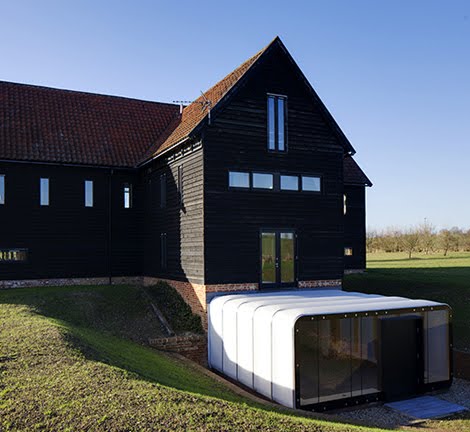

House 12.20 in Campo Grande, Brazil by Alex Nogueira




Copy is courtesy of the architect:
In a 9-meter-long (29.5') and 5-meter-wide (16.4') rectangular space, totaling 45 square meters (about 148 square feet), the orthogonality and the rigidity of the architectural environment create a contrast with the light and stripped atmosphere brought by the colors, by the furniture, by some of the finishes, and by the generous opening which faces the garden.

In this space there are, almost in a symbiotic way, the room, the office, the kitchen, the bedroom, and the hall, where the furniture is the keystone in both aesthetic and functional harmony of this multiple environment. The bathroom is the most conventional setting and it divides the hydraulic wall with the kitchen, but it is turned to the room, privileging this more intimate access.

Generally speaking, the homogeneity of the internal space is an attempt of dialogue with the homogeneity of the external space, the green plane composed by the hearty garden. In this search, both the large sliding glass door and outside deck are responsible for integrating and transporting the external space to the internal one, and vice versa.

The structural system favors the natural look of its different elements. So, there are together, in a mixed system, reinforced concrete with metal profiles. In other words, a metal frame supported by concrete bases, which maintains the construction away from the ground, gives it a certain lightness and a better relationship with the hot weather of the region.

On the front facade, a large layout of horizontal metal louvers not only provides the necessary sun protection but also a uniform, closed, and hermetic aesthetic, in full contrast to the back facade, fully transparent and open. This duality can be understood as a reflection a personality: serious at first, and more open in intimacy.




Exploring a predictable, rigid, and formal geometric body, there was a search for lightness, surprise, and certain enchantment, whether with the yellow sculpture that rests in the garden (made with leftovers of the type "I" metal profiles), whether with the contrasts between the solid wall of exposed concrete and the floating metal wall, whether in the mixture of very different materials such as the simple apparent clay brick (external floors), the transparent glass, corrugated metal closure, unpolished marble, yellow wall, or even crude and poorly finished concrete... Even though it is a small construction, the search was for an architectural experience capable of harboring the infinity of feelings.
Principal Architect: Alex Nogueira
Project Details:
• Year 2009
• Work started in 2010
• Work finished in 2013
• Plot (m²) 720
• Total area (m²) 45
• Status Completed works
• Type: Modular/Prefabricated housing /
Photos © André Barbosa











































